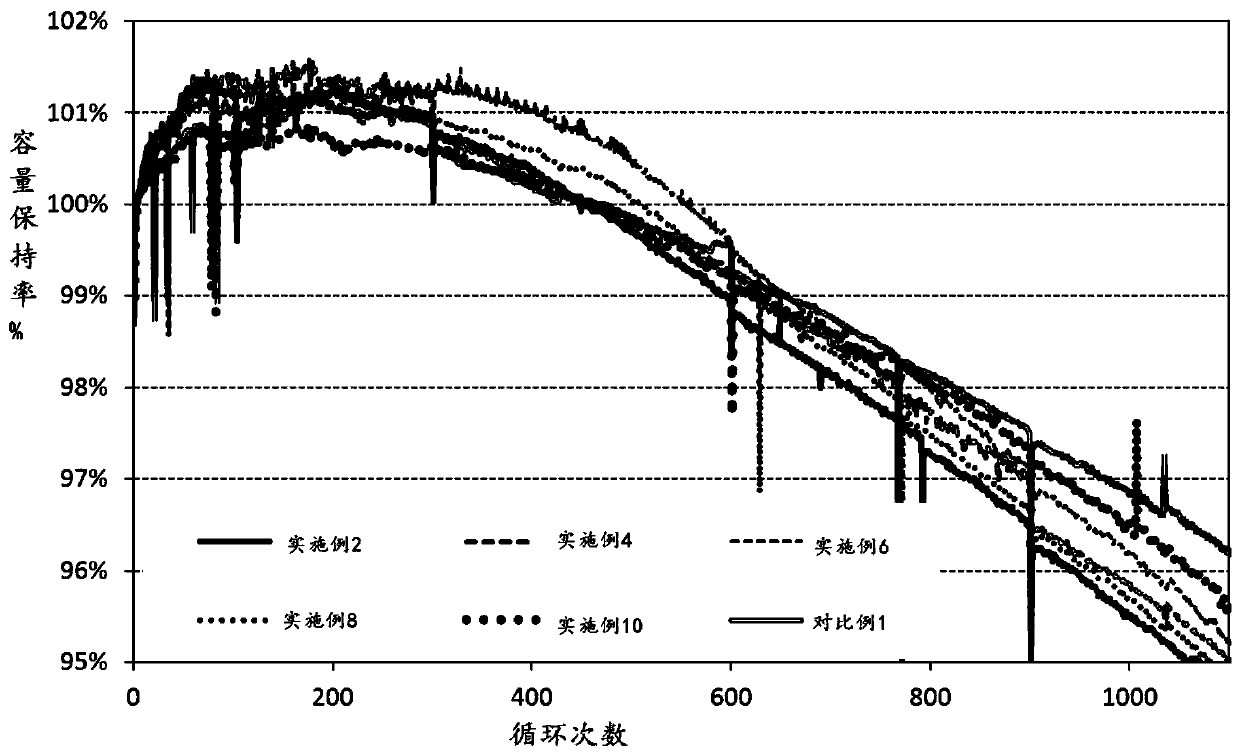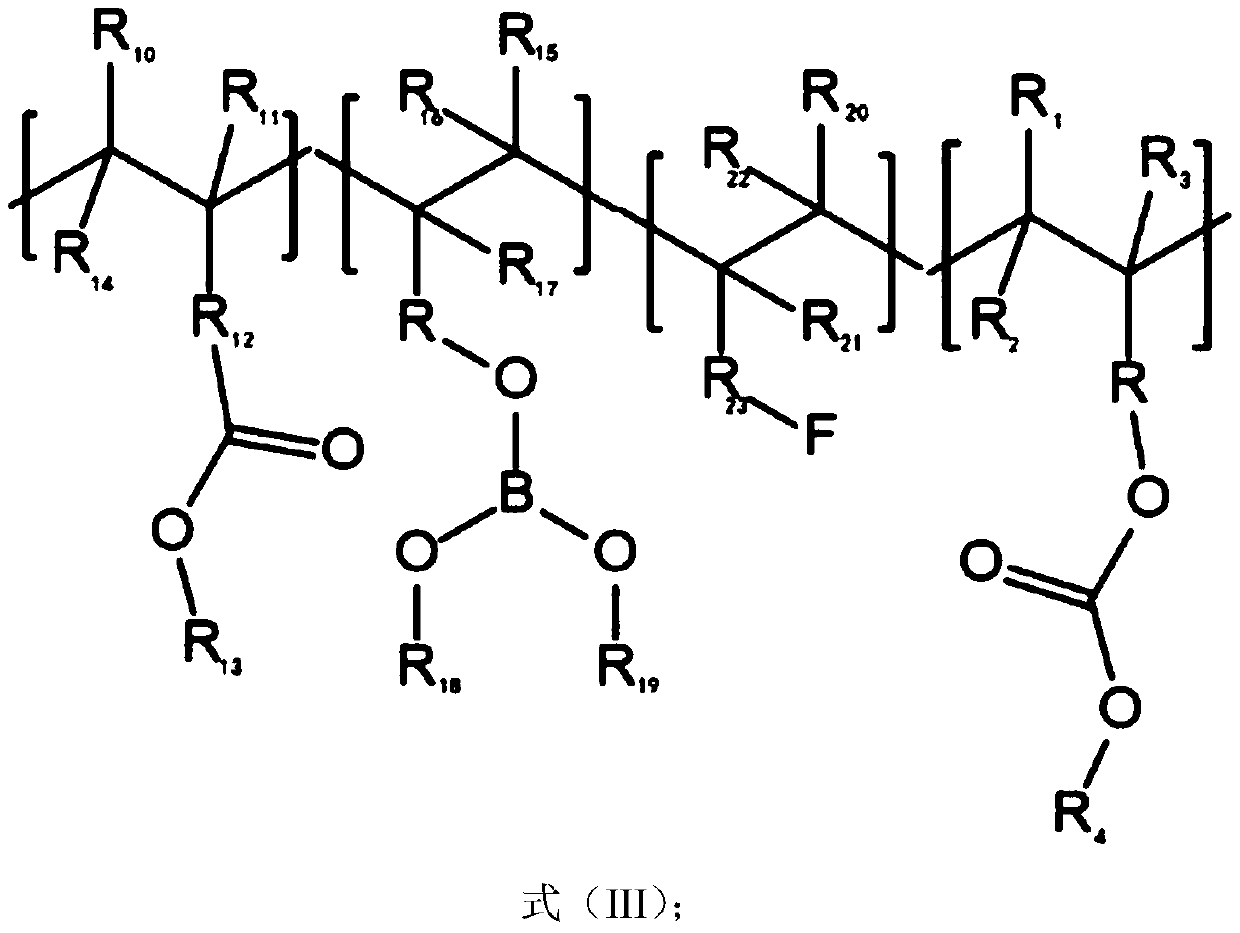Polymer electrolyte and lithium ion battery comprising same
A polymer and electrolyte technology, applied in the field of lithium-ion batteries, can solve the problems of difficult processing, oxidative decomposition of electrolytes, and inability to apply high energy density battery systems.
- Summary
- Abstract
- Description
- Claims
- Application Information
AI Technical Summary
Problems solved by technology
Method used
Image
Examples
Embodiment 1
[0071] This embodiment discloses a method for preparing a polymer electrolyte, including:
[0072] (1) In parts by weight, 20 parts of polymethyl methacrylate and 10 parts of polymethyl acrylate are added to 5 parts of allyl methyl carbonate, 25 parts of ethylene carbonate, 5 parts of allyl di Glycol dicarbonate, 3 parts propylene heptanoate, 4 parts itaconic anhydride, 8 parts propylene hexanoate, 3 parts dipropylene phthalate, 6 parts 2-methacrylic anhydride, 6 parts allyl acetate ester, 2 parts of 2-vinyl-4,4-dimethyl-2-oxazolin-5-one, and 3 parts of methacryl alcohol acetate reagent, and after mixing evenly, A system is obtained, in which The mass proportion of the functional polymer (i.e. 20 parts of polymethyl methacrylate and 10 parts of polymethyl acrylate) is 30%;
[0073] (2) After mixing 100 parts of system A and 0.01 part of triallyl borate functional additive, add lithium perchlorate (LiClO 4 ), lithium hexafluorophosphate (LiPF 6 ) (mass ratio is 1:5), until t...
Embodiment 2
[0076] This embodiment discloses a preparation method of a lithium ion battery, comprising:
[0077] S1: In parts by weight, add 0.01 part of polystyrene to 2 parts of diallyl carbonate, 1 part of allyl trifluoroacetate, and 2 parts of propylene acetoacetate reagent, and mix uniformly to obtain system A, wherein The mass proportion of functional polymer (ie 0.01 part of polystyrene) in system A is 0.2%;
[0078] S2: After mixing 50 parts of system A, 6 parts of allyl pentafluorobenzene, and 6.5 parts of 1,2,2-trifluorovinyltriphenylsilane, add lithium hexafluorophosphate (LiPF 6 ), lithium hexafluoroarsenate (LiAsF 6 ), lithium tetrafluoroborate (LiBF 4 ), lithium bisoxalate borate (LiBOB) (mass ratio is 5:2:1), until the lithium salt is fully dissolved and the concentration of the lithium salt in the mixed solution is 1.1mol / L;
[0079] S3: adding the mixed solution into the battery cell, performing in-situ polymerization and bonding after hot pressing at 80° C. to obtain ...
Embodiment 3
[0086] This embodiment discloses a method for preparing a polymer electrolyte, including:
[0087](1) Add 2 parts of polyacrylonitrile, 10 parts of polymethyl methacrylate, 6 parts of polyvinyl acetate, 2 parts of polyvinylidene fluoride-hexafluoropropylene to 2 parts of diallyl pyrocarbonate, 10 parts Ethylene carbonate, 4 parts of allyl phenyl carbonate, 20 parts of 2-methenylbutyrolactone, 20 parts of dimethylaminoethyl acrylate, 4 parts of hexafluoroisopropyl methacrylate, 1 part of methyl 1H, 1H-perfluorooctyl acrylate, 5 parts of trifluoroethyl methacrylate, 4 parts of isooctyl acrylate, and 10 parts of 4-hydroxybutyl acrylate reagent, and mixed uniformly to obtain A system, wherein The mass proportion of functional polymers in system A (i.e. 2 parts of polyacrylonitrile, 10 parts of polymethyl methacrylate, 6 parts of polyvinyl acetate and 2 parts of polyvinylidene fluoride-hexafluoropropylene) is 20%;
[0088] (2) 90 parts of system A, 2 parts of trans-3-phenylpropen-...
PUM
| Property | Measurement | Unit |
|---|---|---|
| Conductivity | aaaaa | aaaaa |
Abstract
Description
Claims
Application Information
 Login to View More
Login to View More - R&D
- Intellectual Property
- Life Sciences
- Materials
- Tech Scout
- Unparalleled Data Quality
- Higher Quality Content
- 60% Fewer Hallucinations
Browse by: Latest US Patents, China's latest patents, Technical Efficacy Thesaurus, Application Domain, Technology Topic, Popular Technical Reports.
© 2025 PatSnap. All rights reserved.Legal|Privacy policy|Modern Slavery Act Transparency Statement|Sitemap|About US| Contact US: help@patsnap.com



